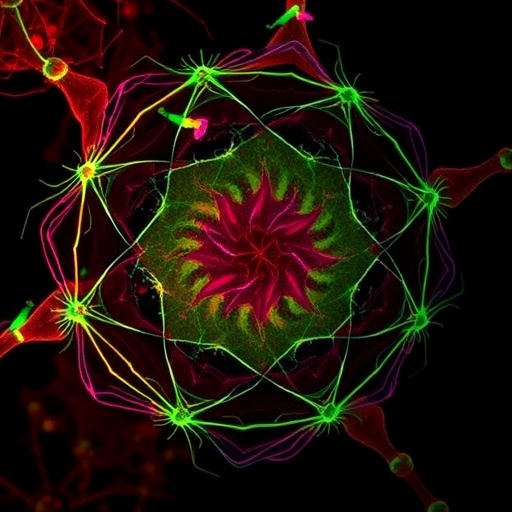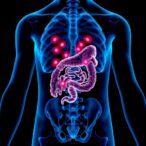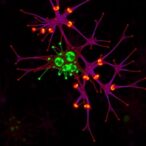
In a groundbreaking study published recently in Cell Death Discovery, researchers have unveiled a novel molecular mechanism that accelerates the degeneration of intervertebral discs, spotlighting the intricate interplay between RNA modifications and cellular aging processes. This new insight revolves around the m6A (N6-methyladenosine) modification pathway and its profound effects on nucleus pulposus cells (NPCs), which play a pivotal role in maintaining the structural integrity and function of intervertebral discs. As back pain increasingly affects millions worldwide, understanding the cellular drivers of disc degeneration opens promising avenues for therapeutic intervention.
Intervertebral disc degeneration (IVDD) is a leading cause of chronic lower back pain and disability, impacting not only individual quality of life but also imposing a significant societal healthcare burden. The degeneration primarily originates in the nucleus pulposus — the jelly-like core of the discs that cushions vertebrae and endures mechanical stress. NPCs are fundamental to disc homeostasis but are prone to premature senescence under pathological conditions, hastening tissue breakdown and loss of disc function. While prior studies have linked cellular senescence with IVDD progression, the precise molecular regulators orchestrating this decline remained elusive until now.
The research team, led by Liu, Xu, Zhang, and colleagues, focused on a critical transcription factor, ELF1, which they discovered acts as a key activator of the methyltransferase METTL3 and the methylation-reader protein YTHDF2. These molecules constitute the cellular machinery responsible for introducing and interpreting m6A modifications on RNA transcripts, a post-transcriptional regulatory mechanism gaining recognition for its role in controlling RNA stability and translation. Their study illuminates how ELF1-mediated enhancement of METTL3 and YTHDF2 levels precipitates accelerated senescence in NPCs by selectively destabilizing particular mRNA targets.
.adsslot_vjXL0RmNDP{ width:728px !important; height:90px !important; }
@media (max-width:1199px) { .adsslot_vjXL0RmNDP{ width:468px !important; height:60px !important; } }
@media (max-width:767px) { .adsslot_vjXL0RmNDP{ width:320px !important; height:50px !important; } }
ADVERTISEMENT
Central to this axis is the mRNA encoding E2F3, a transcription factor essential for cell cycle progression and DNA replication. Liu et al. revealed that m6A modifications orchestrated through METTL3 and recognized by YTHDF2 promote the rapid degradation of E2F3 mRNA, effectively throttling the regenerative capacity of nucleus pulposus cells. As E2F3 is downregulated, NPCs lose their proliferative vigor and enter a senescent state characterized by growth arrest and secretion of pro-inflammatory factors, further magnifying tissue dysfunction and promoting the degenerative cascade.
Delving deeper into the molecular underpinnings, the authors employed a series of cutting-edge genomic and biochemical techniques, including RNA immunoprecipitation sequencing (RIP-seq) and chromatin immunoprecipitation (ChIP), enabling precise mapping of ELF1 binding sites and m6A modification landscapes. These high-resolution analyses delineated the direct transcriptional activation of METTL3 and YTHDF2 by ELF1, and the subsequent m6A-dependent targeting of E2F3 mRNA for degradation. This finely-tuned regulatory network exemplifies how epitranscriptomic control shapes cellular fate decisions within the intervertebral disc microenvironment.
The implications of these findings extend beyond mechanistic insights. By experimentally silencing the components of this axis — specifically METTL3 or YTHDF2 — the researchers were able to partially rescue NPCs from senescence, restoring proliferation rates and alleviating degenerative phenotypes in vitro. Such therapeutic manipulation of the m6A pathway holds tantalizing potential for developing treatments aiming to halt or even reverse IVDD progression, a condition hitherto managed primarily through symptomatic relief or invasive surgery.
Additionally, this study positions ELF1 as a potential master regulator within the context of intervertebral disc pathology. Given that ELF1 is involved in a broad spectrum of gene regulatory networks, its identification as a driver of METTL3/YTHDF2 expression opens new investigative pathways linking transcriptional control to epitranscriptomic modulation. Future research may explore whether similar mechanisms operate in other degenerative diseases where m6A-mediated RNA dynamics affect cellular aging and tissue integrity.
Importantly, the use of m6A modifications as molecular switches controlling RNA destiny adds a new dimension to our understanding of gene expression regulation in musculoskeletal aging. Unlike genetic mutations or DNA methylation, m6A modifications can reversibly modulate RNA stability and translation, offering dynamic adaptability to environmental and cellular stress signals. This ability may explain how NPCs respond maladaptively to chronic mechanical stress or inflammatory triggers, culminating in premature senescence and disc breakdown.
Beyond its immediate relevance to IVDD, the study broadly emphasizes the emerging significance of epitranscriptomics in stem cell biology and tissue regeneration. The fine balance between RNA methylation writers, readers, and erasers controls essential cellular processes, including proliferation, differentiation, and apoptosis. By targeting these regulators, scientists could potentially reprogram aging cells or alter tissue microenvironments to favor repair and longevity.
The team’s innovative approach also highlights the critical interplay between transcription factors and RNA-binding proteins in dictating cellular outcomes. The feed-forward loop whereby ELF1 enhances METTL3 and YTHDF2 expression, which in turn modulate transcript stability, exemplifies a complex regulatory motif that might be conserved across multiple biological systems experiencing stress or injury.
Given the global rise of degenerative musculoskeletal disorders linked to aging populations, such insights are particularly timely. Development of small molecules or RNA-based therapeutics targeting m6A enzymes may transform clinical management, enabling disease-modifying interventions. Clinical translation will require extensive validation in animal models and human tissues, but the current findings lay foundational groundwork for such endeavors.
The discovery also raises intriguing questions about the potential systemic impact of m6A dysregulation beyond NPCs. Could similar m6A-related mechanisms underlie senescence in other cell types involved in spinal health, such as annulus fibrosus cells or chondrocytes? Moreover, do environmental factors — like mechanical overload, inflammation, or metabolic alterations — feed into this axis, exacerbating m6A-mediated transcript destabilization?
In conclusion, the elucidation of the ELF1-METTL3/YTHDF2-E2F3 pathway as a driver of nucleus pulposus cell senescence represents a paradigm shift in our understanding of intervertebral disc degeneration. This epitranscriptomic mechanism not only reveals fundamental biology governing cell fate in aging tissues but also opens innovative therapeutic horizons for a condition with immense medical and social relevance. As research advances, targeting RNA modifications may emerge as a versatile strategy for combating degenerative diseases and improving musculoskeletal health.
Subject of Research: Intervertebral disc degeneration, nucleus pulposus cell senescence, m6A RNA methylation, ELF1 transcription factor, METTL3/YTHDF2-mediated mRNA regulation.
Article Title: ELF1-mediated transactivation of METTL3/YTHDF2 promotes nucleus pulposus cell senescence via m6A-dependent destabilization of E2F3 mRNA in intervertebral disc degeneration.
Article References: Liu, XW., Xu, HW., Zhang, SB. et al. ELF1-mediated transactivation of METTL3/YTHDF2 promotes nucleus pulposus cell senescence via m6A-dependent destabilization of E2F3 mRNA in intervertebral disc degeneration. Cell Death Discov. 11, 267 (2025). https://doi.org/10.1038/s41420-025-02515-8
Image Credits: AI Generated
DOI: https://doi.org/10.1038/s41420-025-02515-8
Tags: cellular senescence mechanismschronic lower back painchronic pain management strategiesELF1 transcription factorhealthcare burden of back painintervertebral disc degenerationm6A RNA modificationmolecular pathways in disc healthnucleus pulposus cell agingRNA modifications in agingtherapeutic interventions for IVDDtissue breakdown in intervertebral discs



